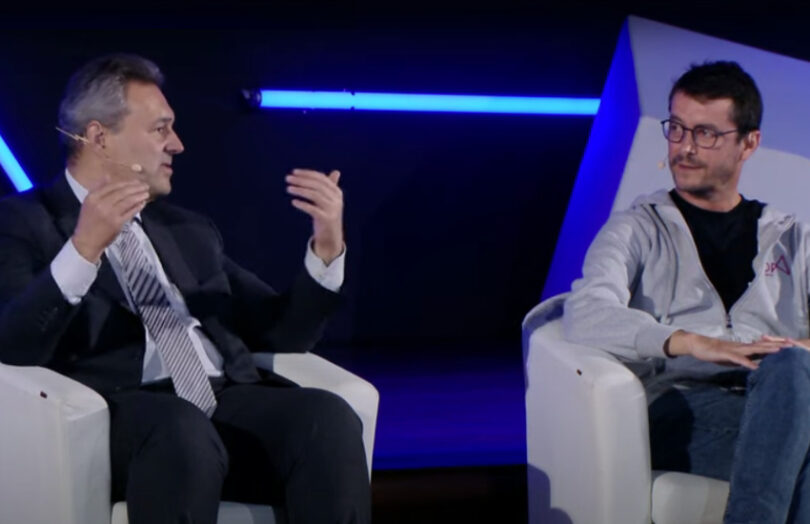Without intervention, it might take traditional finance (TradFi) ten to 20 years to adopt blockchain, said Olivier Roucloux of Euroclear. That’s partly because some organizations are unwilling to invest. However, if there’s a route with minimal investment, that could be a game changer. Swift is exploring such a path.
In late August, Swift shared the results of a blockchain interoperability trial including BNP Paribas, Citi, the DTCC, Euroclear and several others. Chainlink was the blockchain partner providing its cross chain solution.
But the work is much more than interoperability between blockchains. It’s just as much about enabling access to DLT in the language institutions speak today, which is Swift messaging.
Yesterday at a Chainlink event, Swift’s Thomas Dugauquier said, “Where I see the power of using Swift messages is in a short window of time to try to unlock trading of digital assets.”
He described an investment bank not connected to blockchain sending a Swift message instructing its custodian bank to buy a digital asset. The custodian can then execute an on chain transaction on its client’s behalf. In a short time, a small number of connected institutions can enable access to blockchain’s tokenization for the 11,000 Swift enabled banks.
Alexandre Kech of SIX Digital Exchange (SDX) acknowledged that the current eight members of SDX neither host their own nodes nor manage their private keys. Instead, SDX uses the FIX protocol for trading and Swift for settlement to ensure seamless integration with current systems. Hence, something like Swift’s solution can enable institutions at different stages of development to reap many of the benefits of tokenization.
As ANZ’s Anurag Soin put it, “If there is any way to get a billion users on-chain, this is one of the ways.”
Fragmentation versus blockchain interoperability
Someone recently noted that the current fragmentation with numerous institutions launching siloed DLT networks is natural for blockchain’s innovation phase. However, as it transitions from exploration to production, there’s a need to address this problem.
Dozens of solutions aim to tackle the challenge, ranging from the Regulatory Liability Network to Ownera’s FINP2P and solutions such as Digital Asset’s Canton Network, and R3 and Adhara’s Harmonia. Swift is trialing Chainlink’s Cross-Chain Interoperability Protocol (CCIP).
“If the promise (of blockchain) is efficiency, can we move to a model that delivers inferior results?” asked ANZ’s Anurag Soin. “Interoperability is really important to deliver that promised efficiency.”
SDX’s Kech put it a slightly different way. “Our job is not to play with technology,” he said. “It’s to offer services to members that they can use (so) that a bond issued on blockchain has the same value as a bond issued on traditional finance.”
All the panelists believe there will be multiple blockchains. Euroclear’s Roucloux pointed to several reasons. European legislation means you can’t share a DLT with a non EU institution. Most asset classes will reside in separate blockchains. And that includes the digital cash needed for settlement.
ANZ’s Soin discussed different public blockchains. Executing high value transactions directly on Ethereum might be more expensive, but with a large number of validators, the network is considered more secure. Low ticket transactions could use other blockchains.
Soin also noted the potential for atomic settlement to unlock significant capital. The need for atomic settlement opened up a debate.
Does TradFi want atomic settlement?
To transition banks from off-chain to on-chain, we need to understand their pain points, said Euroclear’s Roucloux. He believes atomic settlement is not one of them. While he didn’t give reasons, that’s likely because netting payments also yields significant efficiencies.
On the other hand, he noted programmability can help automate the life cycle of a bond. However, these are activities that a central securities depository (CSD) such as Euroclear would usually manage. Hence, post issuance the CSD becomes an observer.
That contrasts with SDX, whose parent SIX also operates the primary CSD for Switzerland. It has taken a less conservative approach and embraced atomic settlement. As we previously reported, it tokenizes Swiss Francs and is about to use a live wholesale CBDC for a limited time. However, SDX’s Kech also noted that they are looking at pre-funding solutions, including potentially flash loans and collateral-based borrowing and lending protocols similar to web3’s Aave.
SDX’s Kech acknowledged atomic settlement will take time to proliferate but noted the direction of travel is clear.
Roucloux argued that many situations involve five or more intermediaries, making atomic settlement extremely hard.
“I do expect that the number of intermediaries will diminish over time because of the technology itself,” said SDX’s Kech. “Blockchain technology can help (by) having those ‘unnecessary intermediaries’ removed from the list of intermediaries and make markets more easily accessible from anywhere in the world. But of course, that will take time.”






